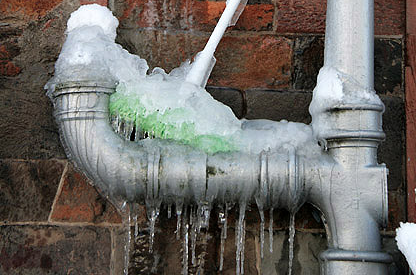Preventing Frozen Pipes: Top Tips for Winter
Preventing Frozen Pipes: Top Tips for Winter
Blog Article
This great article down below involving Winter Plumbing Precautions: Preventing Frozen Pipes is really interesting. Check it out yourself and decide what you think of it.

Cold weather can wreak havoc on your plumbing, specifically by freezing pipelines. Here's how to stop it from occurring and what to do if it does.
Intro
As temperature levels decrease, the risk of icy pipes rises, potentially causing costly repair work and water damage. Recognizing exactly how to stop frozen pipes is crucial for house owners in cool climates.
Prevention Tips
Insulating susceptible pipes
Cover pipelines in insulation sleeves or make use of heat tape to secure them from freezing temperature levels. Concentrate on pipelines in unheated or exterior areas of the home.
Home heating methods
Keep indoor rooms adequately warmed, especially locations with plumbing. Open cupboard doors to permit warm air to flow around pipes under sinks.
How to determine frozen pipelines
Search for reduced water flow from faucets, unusual smells or noises from pipelines, and visible frost on subjected pipes.
Long-Term Solutions
Structural modifications
Think about rerouting pipelines far from outside wall surfaces or unheated locations. Include additional insulation to attics, cellars, and crawl spaces.
Upgrading insulation
Buy top quality insulation for pipes, attic rooms, and walls. Appropriate insulation assists preserve constant temperatures and reduces the danger of frozen pipes.
Securing Outdoor Plumbing
Yard hose pipes and exterior faucets
Separate and drain garden pipes before wintertime. Mount frost-proof faucets or cover exterior taps with shielded caps.
Recognizing Frozen Pipelines
What causes pipes to ice up?
Pipelines ice up when revealed to temperature levels below 32 ° F (0 ° C) for extended periods. As water inside the pipes freezes, it broadens, taxing the pipe wall surfaces and possibly causing them to rupture.
Dangers and problems
Frozen pipelines can lead to supply of water disturbances, residential or commercial property damages, and pricey repairs. Ruptured pipelines can flooding homes and create substantial architectural damages.
Indicators of Frozen Pipeline
Recognizing icy pipes early can prevent them from breaking.
What to Do If Your Pipes Freeze
Immediate actions to take
If you suspect frozen pipes, maintain faucets open up to relieve stress as the ice melts. Use a hairdryer or towels taken in hot water to thaw pipelines gradually.
Conclusion
Avoiding frozen pipelines calls for proactive steps and quick responses. By recognizing the reasons, indicators, and safety nets, home owners can secure their plumbing throughout winter.
5 Ways to Prevent Frozen Pipes
Drain Outdoor Faucets and Disconnect Hoses
First, close the shut-off valve that controls the flow of water in the pipe to your outdoor faucet. Then, head outside to disconnect and drain your hose and open the outdoor faucet to allow the water to completely drain out of the line. Turn off the faucet when done. Finally, head back to the shut-off valve and drain the remaining water inside the pipe into a bucket or container. Additionally, if you have a home irrigation system, you should consider hiring an expert to clear the system of water each year.
Insulate Pipes
One of the best and most cost-effective methods for preventing frozen water pipes is to wrap your pipes with insulation. This is especially important for areas in your home that aren’t exposed to heat, such as an attic. We suggest using foam sleeves, which can typically be found at your local hardware store.
Keep Heat Running at 65
Your pipes are located inside your walls, and the temperature there is much colder than the rest of the house. To prevent your pipes from freezing, The Insurance Information Institute suggests that you keep your home heated to at least 65 degrees, even when traveling. You may want to invest in smart devices that can keep an eye on the temperature in your home while you’re away.
Leave Water Dripping
Moving water — even a small trickle — can prevent ice from forming inside your pipes. When freezing temps are imminent, start a drip of water from all faucets that serve exposed pipes. Leaving a few faucets running will also help relieve pressure inside the pipes and help prevent a rupture if the water inside freezes.
Open Cupboard Doors
Warm your kitchen and bathroom pipes by opening cupboards and vanities. You should also leave your interior doors ajar to help warm air circulate evenly throughout your home.

Hopefully you enjoyed reading our topic about Helpful Tips to Prevent Frozen Pipes this Winter. Thanks a lot for taking the time to read through our content. If you appreciated our blog entry plz don't forget to pass it around. Many thanks for going through it.
Call Today Report this page